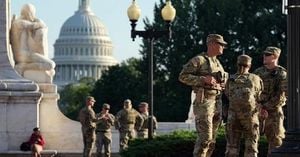After eight long years, the historic al-Nouri Grand Mosque in Mosul, Iraq, has officially reopened its doors, marking a powerful moment of resilience and renewal for a city that has endured some of the harshest chapters of recent history. The reopening ceremony, held in early September 2025 and led by Iraqi Prime Minister Mohammed Shia al-Sudani, was not just a local event—it was a symbol of Iraq’s determination to reclaim its cultural heritage from the ashes of war and extremism.
The mosque, originally constructed in the second half of the 12th century, stood as an iconic landmark in Mosul for nearly 850 years. Its distinctive leaning minaret, al-Hadba, was a beloved feature of the city’s skyline and a testament to the region’s rich architectural legacy. But in 2017, as the so-called Islamic State (ISIL or ISIS) fought desperately to retain control of Mosul against advancing Iraqi military forces, the group detonated explosives inside the mosque, reducing much of the revered structure to rubble. The destruction was not just physical—it was deeply symbolic, as the mosque had been the very site where ISIS announced its self-declared caliphate to the world in 2014, according to Euronews.
In the aftermath of ISIS’s defeat and the liberation of Mosul in 2017, the enormity of the loss was felt across Iraq and beyond. The al-Nouri Mosque was more than a building; it was a cornerstone of Mosul’s identity and a witness to centuries of history. Recognizing the importance of restoring what had been lost, UNESCO, the United Nations’ cultural agency, stepped in to lead the reconstruction efforts, working closely with Iraqi heritage and religious authorities.
Rebuilding the mosque was never going to be a straightforward task. As UNESCO described it, the restoration was “not only an architectural challenge,” but also “a symbolic act of revival.” The first phase of the project began in autumn 2018. The site had to be painstakingly demined and cleared of dangerous materials—a grim reminder of the violence that had taken place there. Teams sifted through the rubble, searching for valuable fragments that could be preserved and reintegrated into the new structure, ensuring a tangible link to the mosque’s storied past.
Funding for the project was substantial, with $115 million (98.2 million euros) raised through international cooperation. The European Union and the United Arab Emirates were among the most significant contributors, reflecting the global resonance of Mosul’s cultural loss and the shared desire to see it restored. The United Arab Emirates, in particular, played a leading role, not just financially but also in championing the project as a beacon of hope and reconciliation in a region scarred by sectarian conflict, as reported by Euronews.
To ensure the restoration honored both tradition and the aspirations of the local community, an international design competition was held. An Egyptian team emerged victorious, presenting their vision to the Iraqi public in May 2022. Their design balanced the desire to faithfully reconstruct the mosque’s essential features—an idea supported by 70% of locals according to a 2020 survey—with the need for thoughtful improvements that would serve future generations.
During the preparatory work, a remarkable discovery was made: four rooms dating from the 12th century, believed to have been used for ablutions, were found beneath the mosque’s floor. These ancient spaces were carefully incorporated into the redesign, adding another layer of historical depth to the project and connecting today’s worshippers with those of centuries past.
Prime Minister Mohammed Shia al-Sudani, speaking at the reopening ceremony, captured the spirit of the occasion. He declared, “The building’s reconstruction will remain a milestone, reminding all enemies of the heroism of Iraqis, their defense of their land, and their rebuilding of everything destroyed by those who want to obscure the truth.” He went on to emphasize the broader significance of cultural restoration, stating, “We will continue our support for culture and efforts to highlight Iraqi antiquities as a social necessity, a gateway to our country for the world, an opportunity for sustainable development and a space for youth to innovate.” These words, reported by Euronews, reflected not only pride in the achievement but also a vision for a more united and forward-looking Iraq.
But the reopening of al-Nouri Grand Mosque is about more than bricks and mortar. It is the flagship project in a larger Iraqi initiative to use cultural heritage as a tool of diplomacy, fostering a sense of collective unity and national pride as the country recovers from years of war. According to Euronews, the restoration has been a deliberate effort to show that Iraq’s heritage can be a bridge, not a wedge, in a society too often divided along sectarian lines.
However, as highlighted by journalist Mohammad Salami, these efforts have not been without their challenges. Iraq’s complex tapestry of religious and ethnic identities means that cultural heritage can sometimes become a battleground for competing narratives. Different groups have sought to claim historic sites for their own, using them to promote exclusionary political or sectarian messages. The al-Nouri project, therefore, stands as both a triumph and a test—a demonstration of what is possible when unity prevails, but also a reminder of the ongoing work required to ensure that heritage truly belongs to all Iraqis.
The restoration’s impact has extended beyond the mosque itself. The same project has also supported the rebuilding of war-damaged churches in Mosul, an effort to preserve the heritage of the city’s dwindling Christian population. Once home to around 50,000 Christians in 2003, Mosul now counts just 20 Christian families as permanent residents. This sobering statistic underscores the broader toll of conflict on the city’s social fabric and the urgency of efforts to protect what remains of its pluralistic heritage.
As the sun set over Mosul on the day of the reopening, the al-Nouri Grand Mosque stood once again as a beacon—of faith, of endurance, and of hope. For many Iraqis, the restoration is not just about reclaiming a building, but about reclaiming a sense of possibility. The path forward may not be easy, and the wounds of the past are far from healed, but the reopening of al-Nouri offers a glimpse of what can be achieved when a community—and indeed, the world—comes together to rebuild.
The echoes of prayer and celebration now fill the halls where silence once reigned, and for the people of Mosul, that sound is perhaps the most powerful sign yet that renewal is possible, even after the darkest of times.




